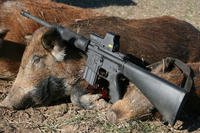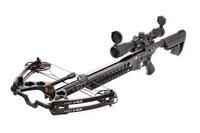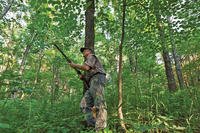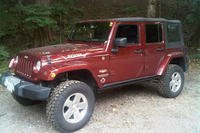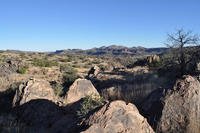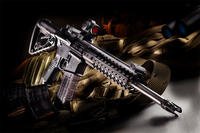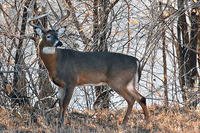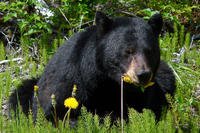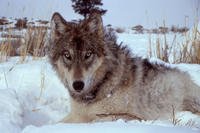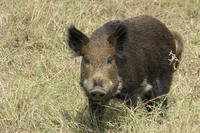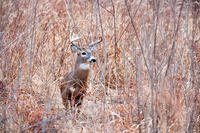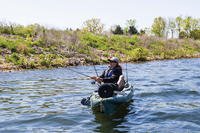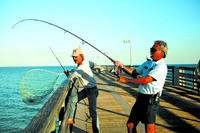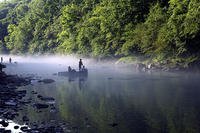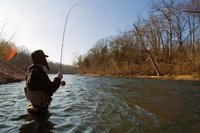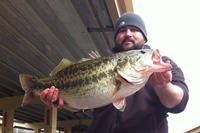A midnight float on a lazy river can yield prime pelts for the stealthy hunter. Float along with the author and his son as they take us on a winter night’s hunt.
By David W. Kaprocki
The temperature hovered at a miserable 27 degrees. It was late December in Pennsylvania, definitely not your typical weather for canoeing. Not only that, but we were canoeing down a small creek, at night, in an attempt to hunt coons and fox. Furthermore, a major snowstorm was forecast to hit us sometime after midnight with up to 10 inches of snow. Do we know how to have fun or what?
My son and I eased the canoe off the bank from our launching point, and soon we spotted the eyes of the first coon of the night 100 yards ahead. Justin was positioned in the bow. He steadied the .22 rifle as I steered the canoe in the raccoon's direction. As the current pushed us downstream, I kept the paddle in the water to ensure the canoe stayed positioned properly so Justin could get a shot. We drifted until we were 20 yards out. One shot and the coon ran up the bank and out of sight. A clean miss! It was already shaping up to be a successful night as far as we were concerned!
We had been planning this trip for over a week and were determined to complete the 7-hour float just ahead of the storm. Our logic was that the animals would be out feeding heavily before the snow hit. With my wife driving a second vehicle, we dropped my truck at the take-out ramp 9 miles downstream from where we'd put the canoe in. She then drove us up to the headwaters and dropped us off with the canoe and our gear. We would float downstream to where the truck was parked. This way no one needed to be there to pick us up. An understanding wife makes this entire process much easier.
I didn't expect to see many coons moving this late in the year, especially with temps in the 20s, but this type of trip is a real adventure because you never know what you'll see each night. Farther downstream Justin spotted something on the bank. As we quietly drifted closer, we identified it as a beaver. It saw us at 10 yards, but didn't know what we were so it swam to within four feet of Justin and then smacked its tail on the water giving us a stern warning. It was an awesome experience. We saw four beavers that night.
That is what makes a float hunt so enjoyable, lots of game moving about. We are always amazed at all the deer we see each trip. Most are just milling around the stream or bedded on the bank. In one area near a weed field we spotted three deer bedded on the bank. So just for fun, I quietly paddled the boat over to them. Using only our red-filtered headlights, I was able to position the canoe so Justin was only 3 feet from a 4-point buck. It was incredible! We find that deer rarely spook from a quiet, floating object.
At one point, unbeknownst to us, a flock of turkeys were roosted in the trees hanging out over the creek. As we drifted under them, they all spooked, dropping poop-bombs around us in the water as they flew off. It startled us so much that I think I left a "bomb" of my own! Bring extra clothes for such occasions.
With snow and sleet moving in, we knew it was going to get nasty, so we continued on our adventure…
Let's look at all the details of a float hunt and break it down into manageable pieces so you understand exactly how you can do this type of hunt. This article will cover: vehicle placement, canoeing, gear, lights, proper clothing, guns, safety, calling, and shooting.
The Right Water
The first step is to find a waterway you can canoe down. It has to be deep enough so you are not scraping rocks on the bottom. Last year we hit a submerged rock at night and went overboard. Luckily it was only a foot deep, so not a big deal for us, but our new electronic caller ended up in the bottom of the creek. The waterway should be long enough so that you can float several miles to make it worthwhile. Ours is a 9-mile section that meanders through hardwoods and agricultural fields-great for coons and fox. This takes about seven hours to float, including time to stop for some fox calling and snacks along the way.
While naturally flowing creeks and small rivers have current to supply the horsepower, you can accomplish much the same on a lake with the aid of an electric trolling motor. They are quiet, the battery lasts for hours at slow speeds, and you can get by with only one vehicle. However, on really cold nights a battery won't last as long, so it might be best to carry two for an extended hunt. Warning: The use of a motor can be the difference between legal and illegal with some state laws, so be sure to check local regulations. Regardless of the propulsion method, the techniques are the same.
What Kind Of Boat?
Once you find a creek that is floatable, you need a canoe or small boat that you can maneuver when necessary. When a coon is spotted, I try to quietly guide the canoe to set up the shot. This is done with me sitting in the stern and using a wooden paddle. Metal paddles sometimes "clank" on the side of the canoe, which will spook anything within hearing range. I try to get the canoe about 10 yards from the creek bank as we float down to the coon. The boat you choose must be small enough so you can easily maneuver it when the time comes to get into kill mode.
Safety is the most important factor. Follow all boating safety rules and plan for any circumstance (especially getting wet). The hardest part of night canoeing is not being able to see the water ahead to avoid potential hazards. It helps if you are familiar with the creek. I've floated our 9-mile section several times during the daytime to become more familiar with the three small rapids we encounter each float. Rapids? Yes, but they are only about 10 yards each. At night you have to "read the water" by looking at the sky reflecting off the water's surface since you can't see the rocks. Hey, I said it was an adventure!
Travel Setup
We utilize a drop-off person who dumps us and all our gear off at the launch site. Prior to this, we park a truck at the end of our float so no matter what time we finish, we have a ride waiting on us. Typically, we leave the house at 9 p.m., hunt all night, and get back to the truck around 4 a.m. Yes, it's a long float, but always exciting and usually rewarding. It's always a bonus doing such a trip with my son or a close friend.
Winter Clothing
It was 27 degrees when we started our last float, and by 4 a.m. it had dropped to 20 degrees. You'll be sitting still for hours so you have to stay warm. Dress in multiple layers, including socks. I start off with polypro insulated underwear, then jeans followed by insulated coveralls. Seems like overkill until several hours into the float when you will appreciate the extra clothing.
I strongly recommend two layers of socks and knee-high rubber boots. You must keep your feet dry at all times. This will be tested getting in and out of the boat along your float trip. I use a hooded sweatshirt to keep the wind off my head and neck, and I never skimp on warm gloves.
A waterproof cooler filled with a change of clothing and boots will be worth the effort if you go overboard. Hypothermia is nothing to mess with, so plan for the worst! The creek we float is only 1 to 2 feet deep, so not a big issue if we do capsize, but if you choose a deeper creek, lake, or river, be extra careful and always wear a personal flotation device. Safety first! Lights
You will need a good headlight that will illuminate the eyes of a coon out to 100 yards. I use my 6-volt fox-hunting headlamp. This setup allows me to keep my light on for the entire trip without losing much of its charge. As we drift downstream, both of us are constantly shining our lights down along both banks looking for raccoons and fox. Don't skimp on a good light. Last year my son was using an old battery and within one mile his light died. This made it almost impossible for him to shoot with just me shining my light. Be sure to use a red filter over the lens to minimize spooking.
The goal here is like any nighttime predator hunt. Use the light for spotting game and then for shooting once you are within range. The key is to be able to illuminate the eyes for aiming purposes.
Rifle Or Shotgun?
We carry a .22 rifle and 12-gauge shotgun in the canoe, ready for use at any given moment. Typically, my son uses the .22 rifle as we drift along looking for coons along the bank. We regularly pull the canoe out of the water and call fox, bobcats, and coyotes along cut fields. This is where I use the 12-gauge. Pulling in to land allows you to stretch your legs, take a pit stop, and break out a snack and hot beverage. This sure refreshes your senses and allows you to reflect on the float up to that point. This is usually several hours into our float.
Handling The Shot
Imagine trying to keep the crosshairs of your rifle on a critter when it's dark, the boat is drifting with the current, and sometimes rocking sideways, all at the same time. Here are some techniques that have worked well for us.
In these situations the shooter is seated in the front-rifle in hand, and ready for the shot-while the person paddling is in the rear seat. The paddler's whole purpose is to keep the canoe in the proper position for the shooter to make the shot.
It's important to move the boat toward the coon as quietly as possible. That's why it's important to spot the target at least 100 yards away. This gives you time to get the boat headed in that direction early enough without being detected. Try to get the boat about 10 to 20 yards from the bank while still 50 yards upstream of your target. Once the canoe is in that position, simply keep the paddle in the water, as quietly as possible, to keep the boat lined up as you drift quietly towards the raccoon.
At the same time you are lining up the canoe, the shooter in the front seat positions his body and rifle, then waits quietly as the boat drifts towards the coon. Stay absolutely motionless, allowing the current to silently take you downstream. Headlights stay focused on the coon to illuminate the eyes. Sometimes, if a coon is feeding along the bank, you might lose sight of him as you are drifting down. Keep calm and still, and eventually you'll spot the eyes as he moves about.
When you get within 20 yards of the animal, the shooter should already have the coon in the scope with the crosshairs centered. At this point the shooter fires when ready. Virtually no movement will be necessary for the shot since the shooter is in position at the first glimpse of eyes. During the shot, everyone in the canoe must remain still until after the shot is taken. This is critical so the shooter can properly aim with minimal movement. It's impossible to have the canoe completely still due to the current moving the boat, but by following these suggestions, you can get a good shot.
Another critical factor of this technique is the shooter must have his light illuminating the animal's eyes. If he doesn't, it will be difficult to see the coon in the scope even if the person in the back of the canoe has his light on the coon as well. The key is to have the shooter's light illuminate the eyes.
With any current, it's very difficult to stop the canoe without making noise. Attempting to back-paddle and slow the canoe will always spook the animal. That's why it's essential to get the canoe lined up early and then drift silently down to the coon. You only get one crack at it. I've tried dropping my small anchor to slow the canoe, but they always seem to detect something unnatural about it and run. Stick to the drift technique; it works like a charm. Of course, electric-motor users can engage the reverse to slow down the drift. However, don't slam it into high reverse because this can create unwanted sound, which can spook the critter. Also, be cognizant of the clicking sound made by an electric motor when switching gears.
Dark nights are the most productive. In moonlight, many coons spook while we are still out of shooting range. This is because the moonlit sky is reflected off the water's surface revealing the canoe's outline as you drift toward the animal. On dark nights there isn't as much reflected light.
It's important to have the shooter and paddler develop a way to communicate without talking. Justin will silently point his finger in the direction he wants me to line up the canoe when we're within the last 50 yards of the coon. Sometimes he wants the canoe slightly angled to make a particular shot, so instead of talking, he points. Work out a few hand signals before leaving the house. A coon will certainly hear any human voice, no matter how quietly whispered.
Critter Calling
The easiest way is to pull the boat up on the bank and set up close by. This is no different than parking your vehicle and walking into the field to call. The advantage is that you are likely to be in country where no one has ever called before. As with any set, wind is a factor, so key on it and keep in mind, with the bank at your back, they can't circle behind you.
The other technique is to position the canoe within 20 yards of the bank, anchor, and then call while sitting quietly. This technique is not as effective at night, as critters may come right up to the bank without any warning, making it difficult to get into position for a shot without being busted. At dawn and dusk, with a bit of light, calling from the boat can be deadly since you have the opportunity to see them coming before they're right on top of you.
End Of The Trip
For once the weatherman was right, and at 1 a.m. the snow started falling, and the wind picked up. We still had three miles to go but didn't care; we were having a ball. We floated past a huge tree that had fallen into the water when Justin signaled me he spotted eyes 75 yards ahead. I lined up the canoe while he got in position with the rifle. At 50 yards we simply let the current push us slowly downstream. Within 30 yards we see it's a red fox sniffing around some logs on the bank. Justin sat quietly with the gun ready as we drifted to within 20 yards. I bumped the paddle against the side of the canoe in an attempt to keep it straight, and the fox ran off! It happens.
Farther along, with snow falling, we spot a coon at the water's edge. I position the canoe, Justin readies the rifle, and we drift down to within 10 yards. After the shot the coon rolls into the water. We retrieved the coon and kept moving.
In the last mile of our float the wind was blowing horizontally upstream into our faces. It was hard to see, squinting, with sleet hitting our eyes. We rounded one more bend and spotted the last coon of the night rooting around some brush along the bank, making it easy for us to drift over to him and put the last prime hide in the boat.
Our final count of animals spotted was 10 coons, two fox, four beavers, one muskrat, one mink, some deer, and a flock of pooping turkeys. We had a great night and took home three prime coon skins.
Float trips are definitely not your typical hunt simply due to the logistics involved. It helps to have boating skills and the ability to "read the water" to avoid potential hazards (trees, rocks, and even beavers). Even the simple tasks of handling a boat are amplified at night, making everything you do a little more challenging. The reward is that game animals are out foraging, and it's amazing what you'll see.
This kind of hunt is a real treasure, an adventure, kind of like being on a nighttime safari. Give it a try with a close friend or youngster, and I guarantee you'll end the night with some wonderful and cherished memories.
